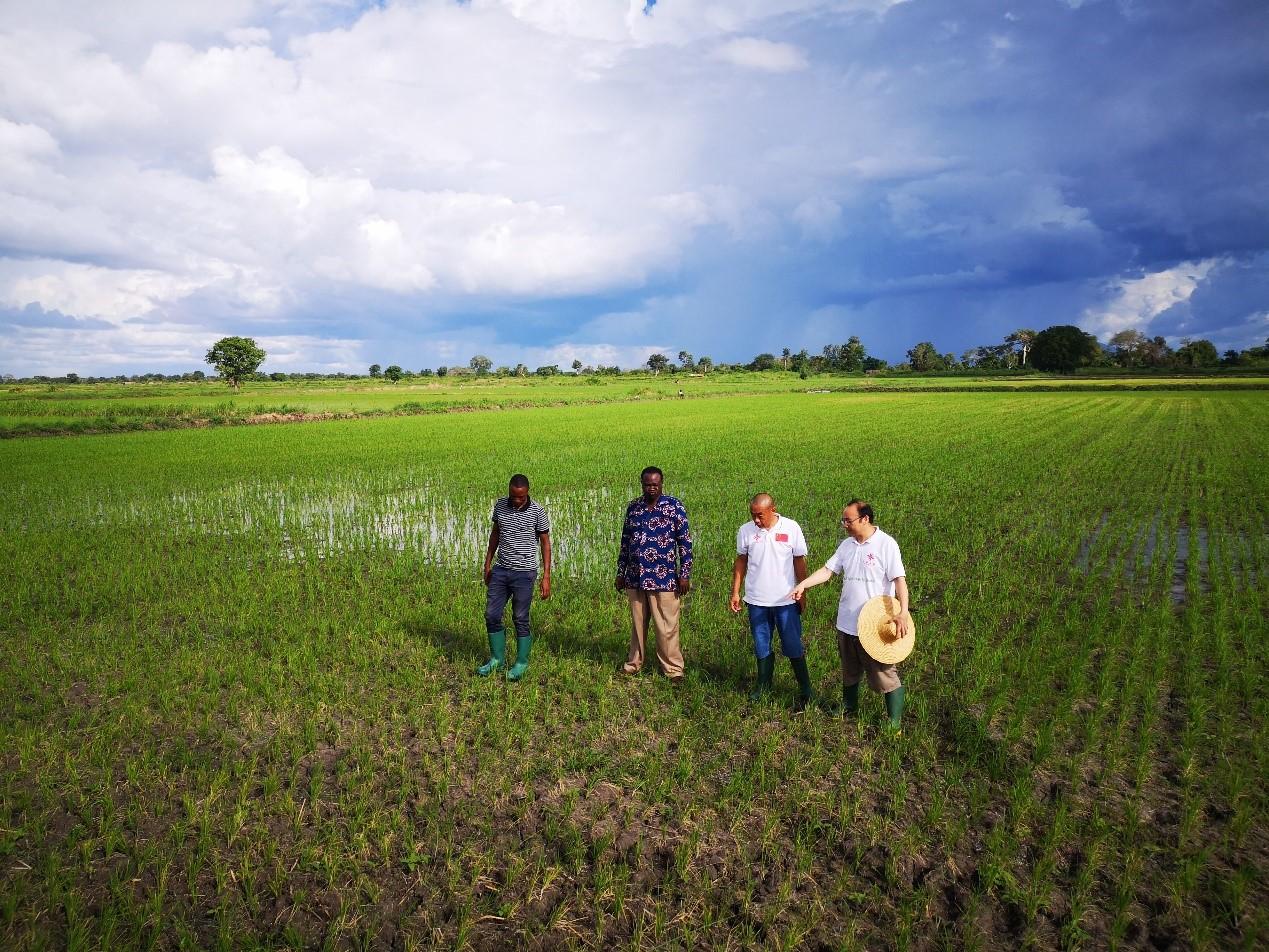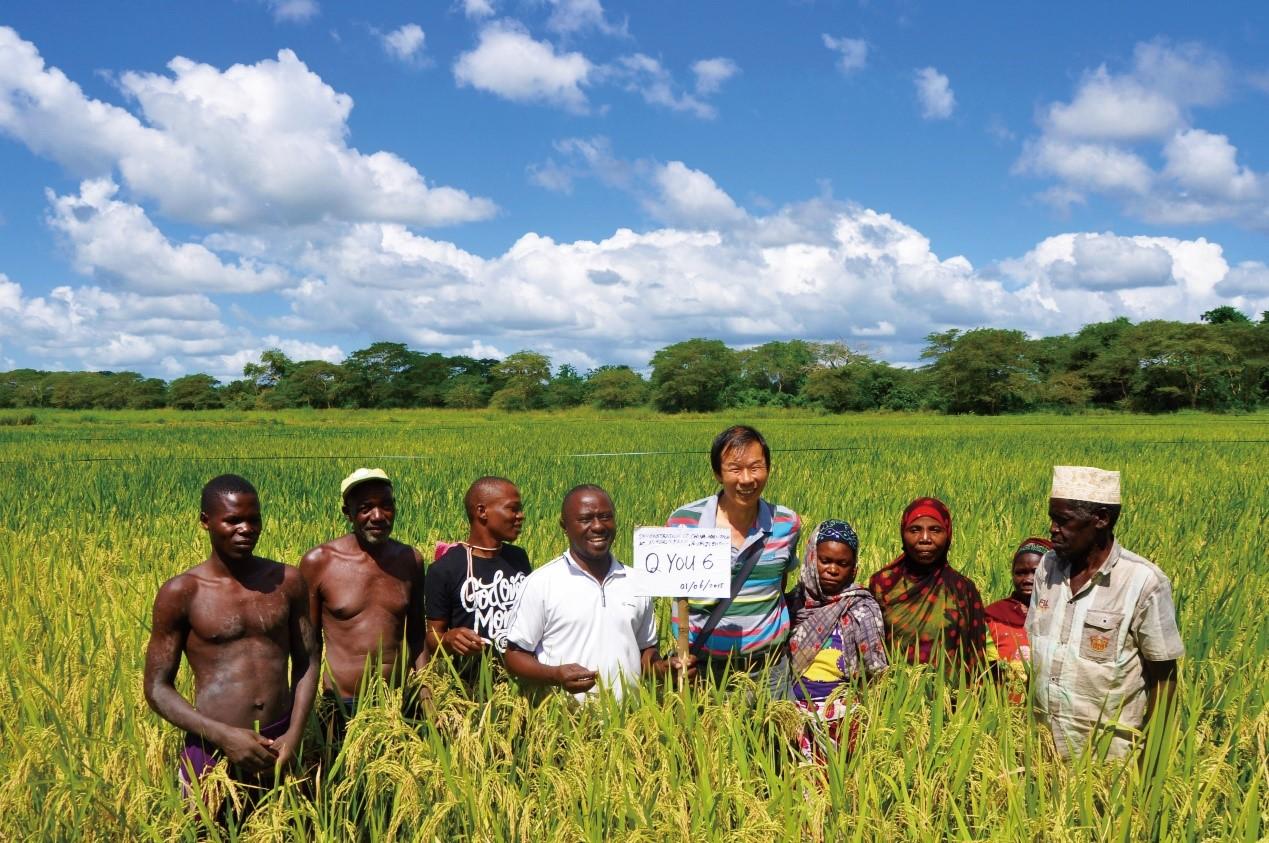
Chinese and Tanzanian agricultural experts assess problems affecting rice growth in a field in Tanzania and discuss ways they can be addressed.
The majority of the world’s impoverished and undernourished people live in rural areas in developing countries and often engage in agricultural activities most of their lives. Part of the United Nations’ list of least developed countries, the United Republic of Tanzania is home to many such people.
From 3-5 Nov. 2006, the Beijing Summit and the Third Ministerial Conference of the Forum on China-Africa Cooperation (FOCAC) were held in Beijing. Established in 2000, the FOCAC is a multilateral platform for exchange and cooperation between China and African countries that have formal diplomatic relationships with China covering areas such as politics, economics, social issues, culture and the environment. Held every three years, the FOCAC’s ministerial conferences have led to a deepening of cooperation between China and African countries and development of the FOCAC system. During the 2006 events, among other actions, the Chinese side decided to:
- Dispatch 100 senior agricultural technology experts to Africa and establish 10 specialised agricultural technology demonstration centres on the continent;
- Provide encouragement and support to Chinese enterprises that want to expand their investment in agriculture in Africa and become more involved in agricultural infrastructure development, agricultural machinery production, and agricultural produce processing on the continent;
- Increase cooperation pertaining to the extension of applicable agricultural technologies and human resources training with Africa.
One of the demonstration centres that China pledged to build during the forums, a site known as the Demonstration Center of China Agricultural Technology was established in Dakawa Village, Mvomero District, Morogoro Region, Tanzania. Cultivation of improved plant varieties developed through selective breeding and various other techniques are demonstrated and local farmers and technicians are provided with agricultural training developed in China at the site, particularly pertaining to rice as Dakawa is one of Tanzania’s major rice production areas. Designed and constructed by a seed company affiliated with the Chongqing Academy of Agricultural Sciences, the site consists of 12 ha’s worth of experimental fields, offices, laboratories, and training facilities as well as an additional 50 ha of irrigated land and was handed over to the Tanzanian government in 2011.
From 24 to 28 Oct. 2011, a body comprised of experts and officials from China and members and observers of the Organisation for Economic Co-operation and Development’s (OECD) Development Assistance Committee (DAC), which promotes development co-operation and other relevant policies in order to contribute to the achievement of the 2030 Agenda for Sustainable Development, including furtherance of inclusive and sustainable economic development, advancement of equalities within and among countries, poverty eradication, improvement of living standards in developing countries, and progression towards a future in which no country will depend on aid, with significant operational experience and detailed knowledge of DAC donor support as well as of China’s aid to foreign countries known as the China-DAC Study Group visited Tanzania.
The Final Report on Joint Study Visit to Tanzania document that was issued by the study group noted that approximately one third of Tanzanians live in poverty and that around 75% are involved with the agricultural industry, the majority of whom are women, but that the sector only contributes a third of the nation’s GDP. It was found that the country’s agriculture is dominated by smallholder farmers that cultivate an average of 0.9 ha to 3.0 ha of land each. The report also noted that approximately 70% of Tanzania’s crop area is cultivated via hand hoe, 20% by ox plough, and that the remaining 10% is cultivated by tractor. Additionally, it stated that the nation’s agriculture is mostly rain fed and that food production dominates – 85% of the 5.1 million ha cultivated annually consists of food crops.
A report that was released by the Tanzanian government indicated that the low agricultural productivity that exists in the country stems from problems such as unstable markets, poor soil fertility, high salinity levels, and droughts as well as utilisation of labour-intensive practices, limited mechanisation and use of improved technology, and lack of innovation, which increase production costs and can cause prices to increase to levels that are higher than those that prevail in global markets. The centre has thus focused on areas such as capacity building, which has resulted in many farmers being trained, including government extension officers.
A Tanzanian Ministry of Agriculture-backed organisation known as the Tanzania Agricultural Research Institute-Dakawa Centre has been introducing improved cultivars and providing farmers and technicians with agricultural training and technologies developed both in China and Tanzania in collaboration with the China Agricultural Technology Demonstration Centre. Initially focusing on rice, the partnership also covers areas such as maize tissue culture, vegetable tissue culture, banana tissue culture, and poultry farming.
“We have jointly undertaken research and developed high-yield seeds that are drought-tolerant,” Tanzania Agricultural Research Institute-Dakawa manager Andrew Ngereza mentioned in 2019. “The centre has demonstrated how these varieties, coupled with modern farming techniques from China, can increase productivity.”
The centre has also been involved with a programme designed to help Tanzanian farmers emerge from poverty by harnessing the power of science and technology known as the Chinese Agricultural Technology Demonstration Tour since 2015 with the support of the Embassy of China in Tanzania. Originally targeting Morogoro, the tour has travelled through the regions of Mbeya, Zanzibar, Mwanza, Pwani, Shimiyu, Ilinga, and Songgu as of the conclusion of 2021.

A participant in the Chinese Agricultural Technology Demonstration Tour, the owner of a large farm located in Rufiji District, Pwani Region, Tanzania, named Zulfikar Mituro (white shirt) poses with students after teaching them rice farming techniques he had previously learned at the Demonstration Center of China Agricultural Technology. Mituro takes part in the tour every year, which enables him to teach people living in other areas various improved farming techniques that help them become more prosperous.
Several years ago, a farmer from Pwani’s Rufiji District named Zulfikar Mituro heard about the Demonstration Center of China Agricultural Technology in Dakawa Village on Saba Saba Day, which is a Tanzanian national holiday observed on 7 July on which the creation of the Tanganyika African National Union in 1954 and the founding of the nation of Tanzania via the unification of Tanganyika and Zanzibar in 1964 are commemorated and the annual two-week-long Dares Salaam International Trade Fair, which has a major impact on business in Central and Eastern Africa, begins.
The father of five soon began receiving technical support and training from Chinese agricultural experts, which made it possible for his rice yields to increase from 3.56 tonnes per ha to 8.55 tonnes per ha.
The upgrade in productivity that has occurred at Mituro’s farm has made it possible for his family members’ lives to improve for the better. The family was able to buy a house in town, and all of his children currently attend school, which is not an easy feat in a country where the majority of people live on less than two U.S. dollars a day measured at 2005 international prices, adjusted for purchasing power parity (PPP).
The success that the Mituros have achieved has attracted the interest of many farmers in the area, and their 40.47-ha farm even became a Demonstration Center of China Agricultural Technology demonstration site. Eager to help teach other rice farmers what he has learned, Mituro also participates in the Chinese Agricultural Technology Demonstration Tour every year, which enables him to teach people various improved farming techniques that boost yields and efficiency and help them become more prosperous.
Français: Un centre-pilote de riziculture
Source:
Chongqing Academy of Agricultural Sciences
For more information, please contact WFP China COE (wfpcn.coe@wfp.org)
Category
China's Agricultural Technology Helps Boost Rice Value Chain in Tanzania
Contributor
China's Agricultural Technology Helps Boost Rice Value Chain in Tanzania
Country
Story

